How to Perform an Effective Twitter Competitive Analysis: Strategies Adapted to the Current Landscape
Learn how to run an in-depth Twitter competitor analysis to enhance your social strategy. Uncover insights and tactics and stay on top of the trends.

Your Twitter marketing feels like shouting into the void while competitors seem to crack the code? Then you’re in need of a solid Twitter competitor analysis.
Social media competitor analysis helps you understand how and why your competitors are gaining followers and driving engagement. It reveals the strategies, content formats, and little tricks that bring results for brands like yours.
Not sure where to start? Through this step-by-step guide, I'll explain to you how to conduct an effective Twitter competitor analysis and use the learnings to create better growth strategies. Let's dive in!
Key takeaways
- Segment competitors into direct, indirect, and aspirational categories for clearer insights.
- Track the right metrics — focus on engagement rates over vanity metrics like follower count.
- Analyze content patterns to find what formats and topics drive real engagement in your industry.
- Turn findings into action with quick wins, medium-term improvements, and long-term strategic shifts.
- Make it regular — competitor landscapes change fast, so regular analysis keeps you ahead.
What is a Twitter competitive analysis?
A Twitter competitive analysis is the process of researching your competitors' strategies, content, and engagement to get performance insights to fuel your own strategy. This includes analyzing your competitors’ Twitter content topics, their posting patterns, and core social media metrics.
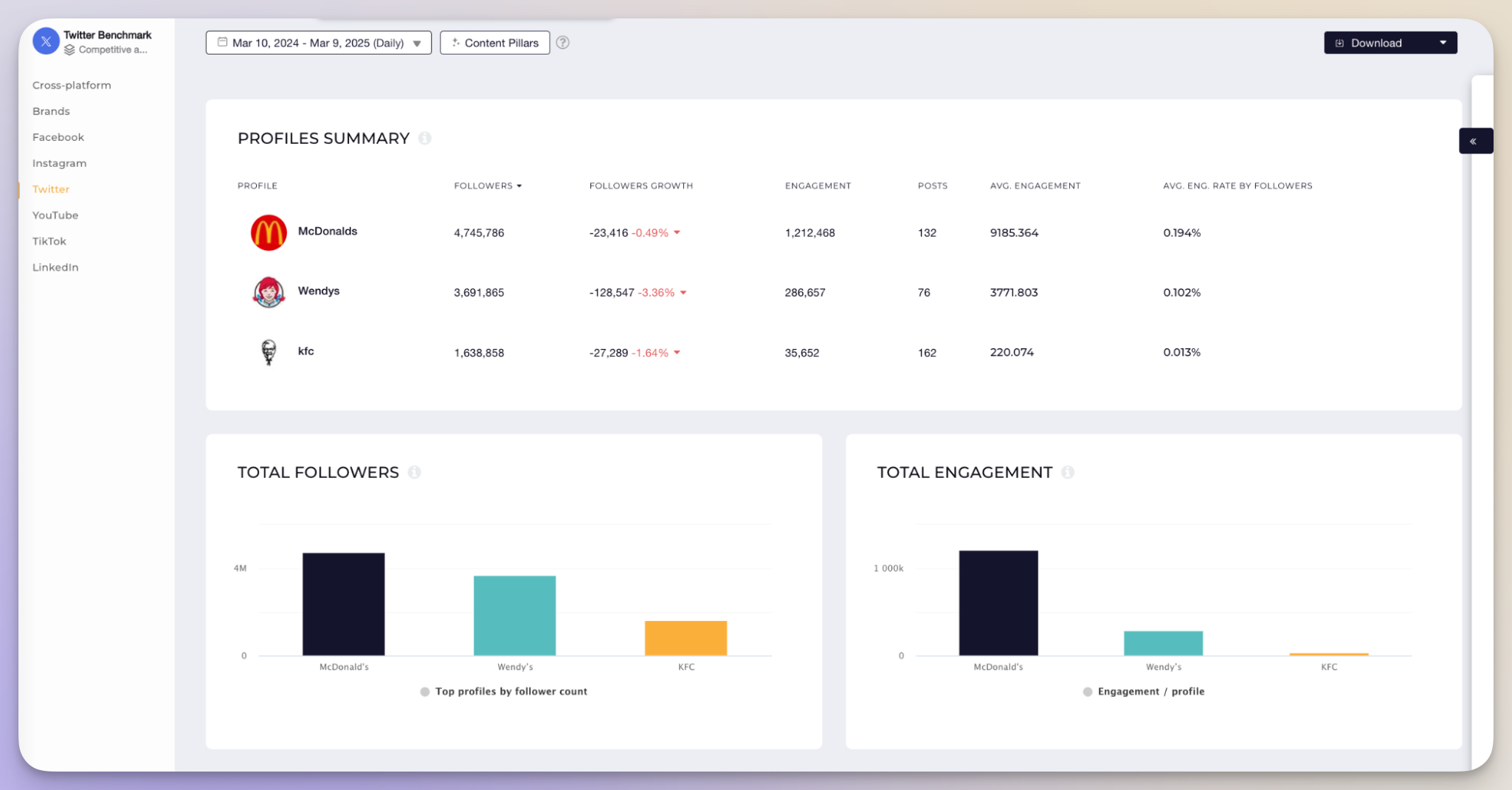
Why run a Twitter performance analysis of competitors?
Twitter competitive analysis is like a reality check: it shows how you’re performing compared to others in your space.
When you track performance and gather analytics on your own accounts, you learn what works for your audience. And that’s immensely important. But competitor analysis gives context to evaluate if what you’re seeing in your social media reports is good or bad.
Besides competitive benchmarks, this research also gives you content ideas and helps spot opportunities. You can learn what works for your competitors to include it in your own content strategy, or find a gap in their content plan that you can fill in.
Being a very rapid-fire platform, Twitter needs you to be one step ahead to rock it. Regular competitor analysis allows you to keep pace with other brands in your niche.
By understanding how people are looking at your vs your competition or vice versa, you may be able to see where your strategy falls short. - Krys van Ovost, Co-founder @ Fox Den Stories
How to perform a Twitter competitor analysis?
So we've established that Twitter competitor analysis helps you stay in context and identify opportunities you haven't seen before. But where do you begin, and most importantly, how do you transform the insights into action?
Here are my recommended five steps for conducting an effective Twitter competitor audit that yields actionable insights.
Establish the competitors you’ll analyze
Before analyzing competitors’ performance on Twitter, you need to identify them. Without clear competitors in your scope, your analysis becomes a mess of random data that won't help you make smart decisions.
This is how I advise you to segment competitors for a clearer picture of the landscape:
- Direct competitors: brands offering the same product or service to the same audience
- Indirect competitors: companies solving the same customer problem but with different approaches
- Aspirational competitors: accounts where you want to be in terms of followers, engagement, or brand positioning
How to identify your competitors?
Naturally, if you work in the industry and do your market research, you already have several names worth tracking.
However, those are usually the obvious ones. Here’s what I advise you to do to discover competitors that you might not know about yet:
- Track mentions. See who gets tagged alongside your brand or in industry conversations.
- Explore hashtags. Search industry hashtags to find accounts posting similar content.
- Check follower overlap. See what similar accounts your followers also follow using social listening tools.
- Search Google or ask ChatGPT. Simple searches for your main keywords or industry often reveal competitors you missed.
Choose the relevant metrics for your analysis
Accessing Twitter analytics for another account manually can be challenging, I know that. But luckily, analytics tools like Socialinsider make it much easier by extracting and aggregating the data you need from any public accounts.
Too many metrics make a competitor analysis report neither readable nor actionable, trust me. That’s why I recommend you focus on the ones that tell you something useful about your competitors' strategy and performance.
Here are the data points that I'm tracking when running an audit:
Profile metrics
- Follower count and growth rate. Shows audience size and momentum. A steady growth rate often matters more than total followers.
- Bio optimization and link strategy. Check if they opt for a funny pun in their bio or use keywords and clear value props. Also, see if there’s a link to drive traffic outside X.
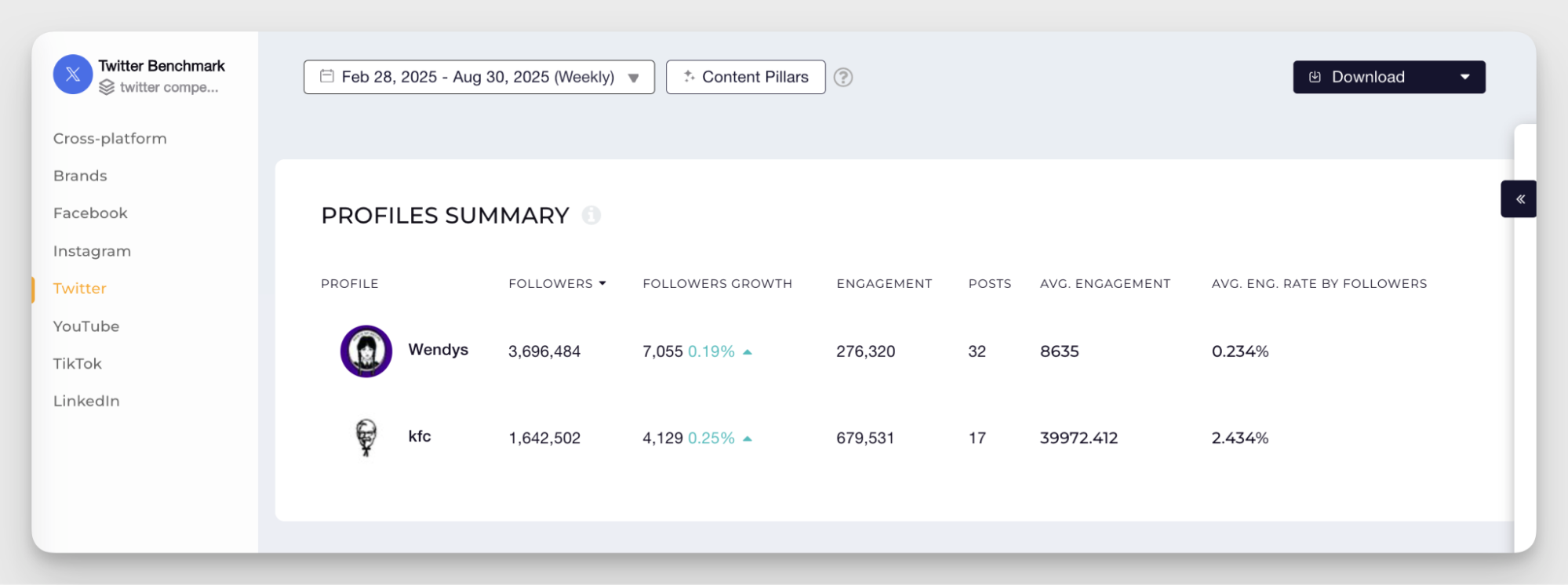
Content metrics
- Posting frequency and timing. Reveals your competitor’s content calendar strategy and when their audience is most active.
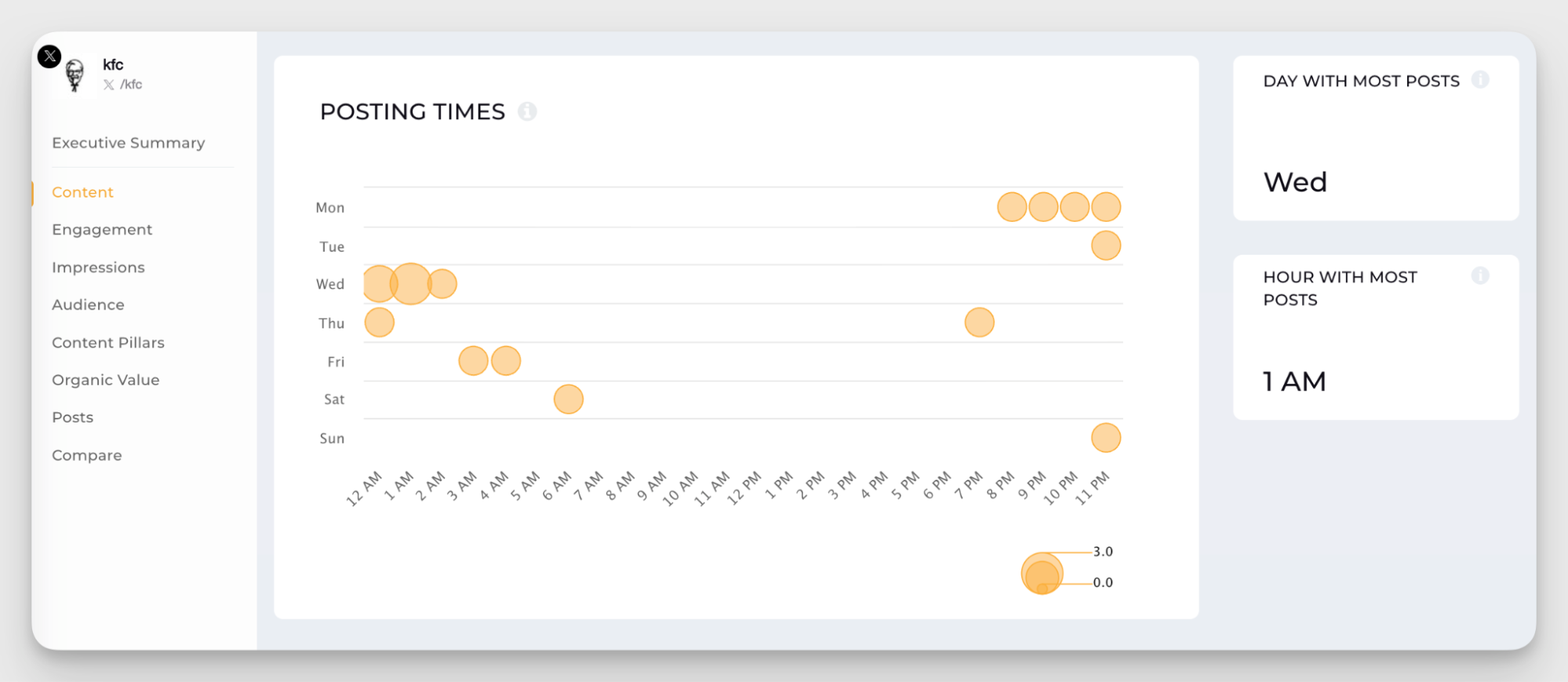
- Content format distribution. See if the competition focuses on text posts, images, videos, or threads to understand what works in your industry.
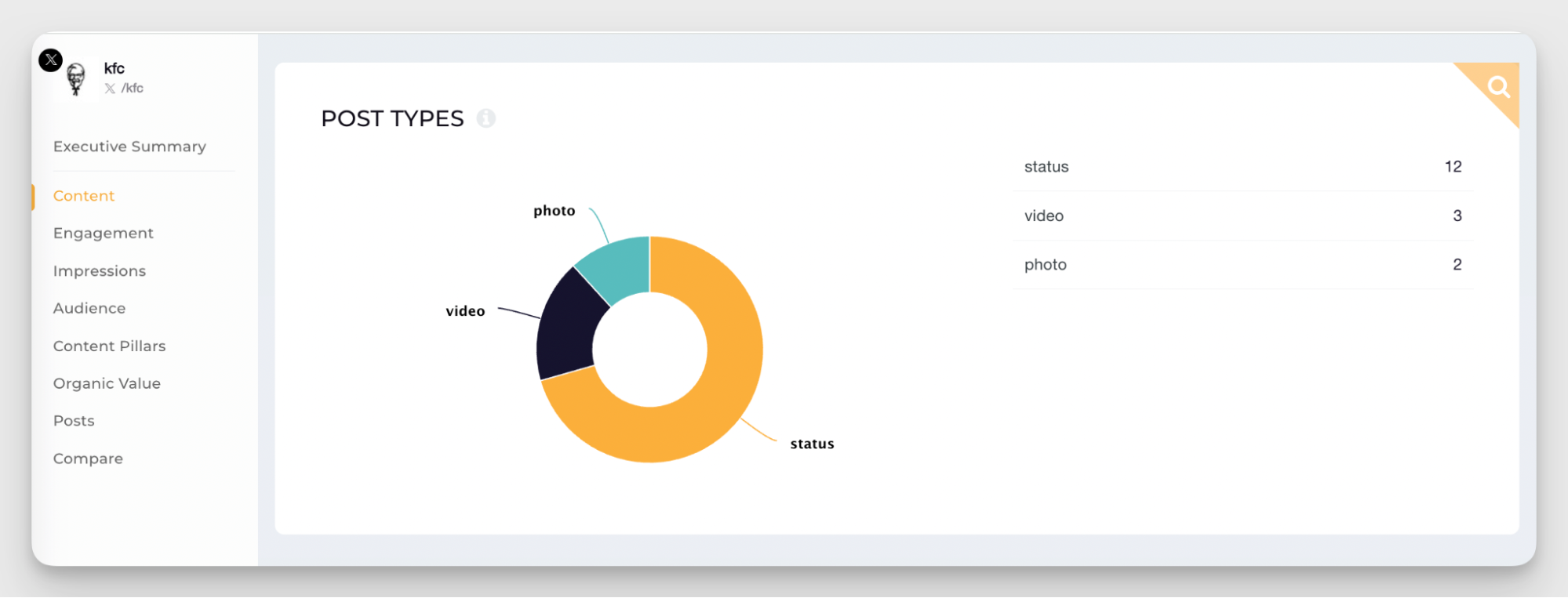
- Tone of voice and copy length. Look at how audiences react to different communication styles (playful vs. official) and whether detailed or short messages work better.

- Hashtag usage patterns. See if competitors use hashtags at all, when they add them, what purpose they serve, and whether it makes any difference.
Engagement metrics
- Retweets, and replies. Basic engagement signals that reveal what content resonates with audiences. My recommendation? Make note of which posts drive more engagement and which ones flop.
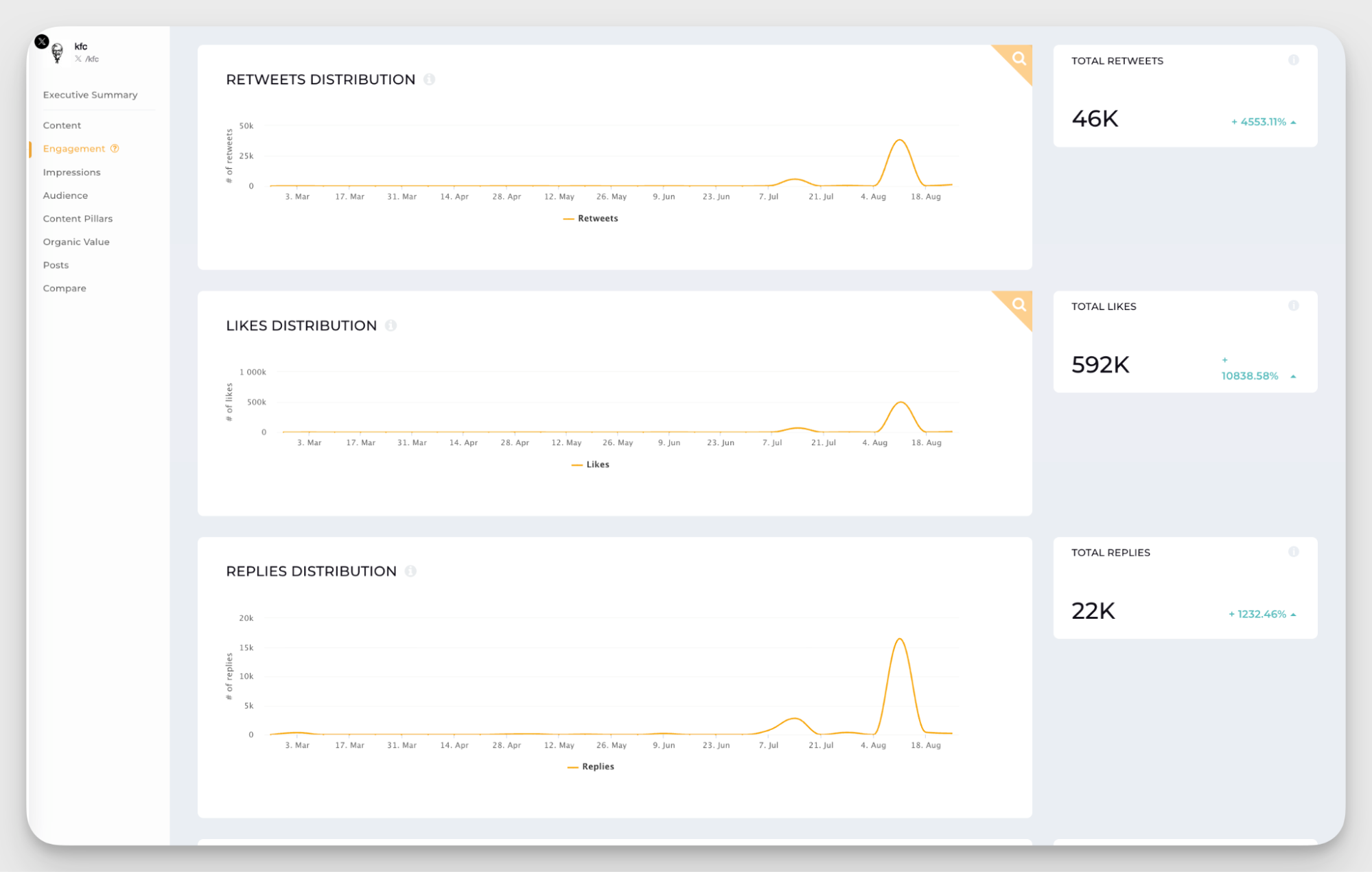
- Engagement rate. The metrics that shows how involved people really are with the brand’s content rather than just how many people saw it. Engagement rate is a little tricky to calculate on your own, but tools like Socialinsider collect the required data to do that for you.
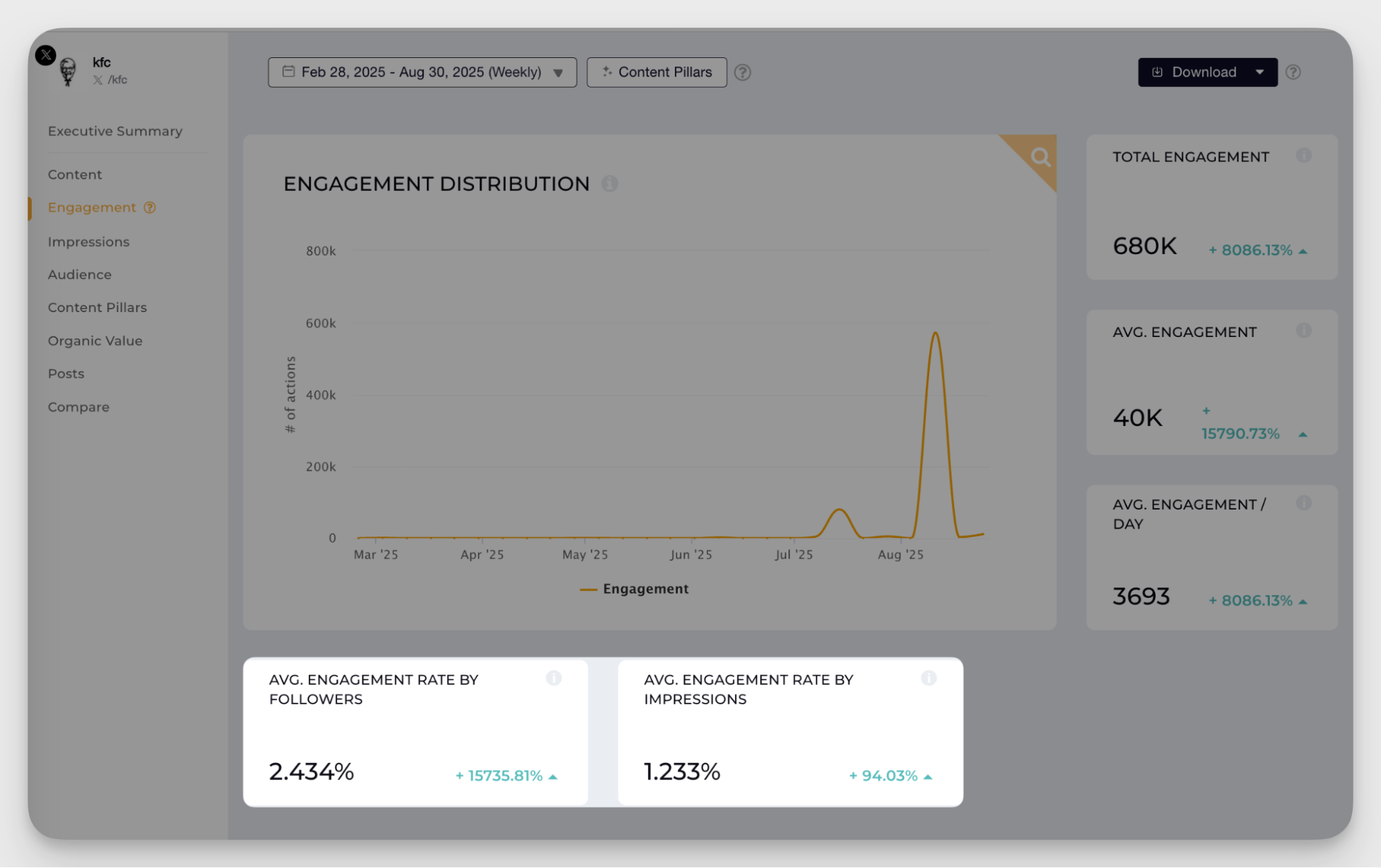
- Community management strategies. Check response times, reply frequency, and conversation style to see how they build relationships.
Analyze your competitor’s Twitter content
However fascinating the social media analytics are, content remains the star of the show. Content analysis is where you find the most substantial insights that can change how you approach Twitter.
Examples always explain it better. Let me walk you through how I'd analyze Twitter content for a fast-food brand like KFC.
I’d start with a content pillars analysis — the core themes and topics your competitors consistently post about. Analyzing these shows you what audiences expect from brands in your space and reveals gaps you could fill with a unique POV.
So here are the KFC’s core content pillars:
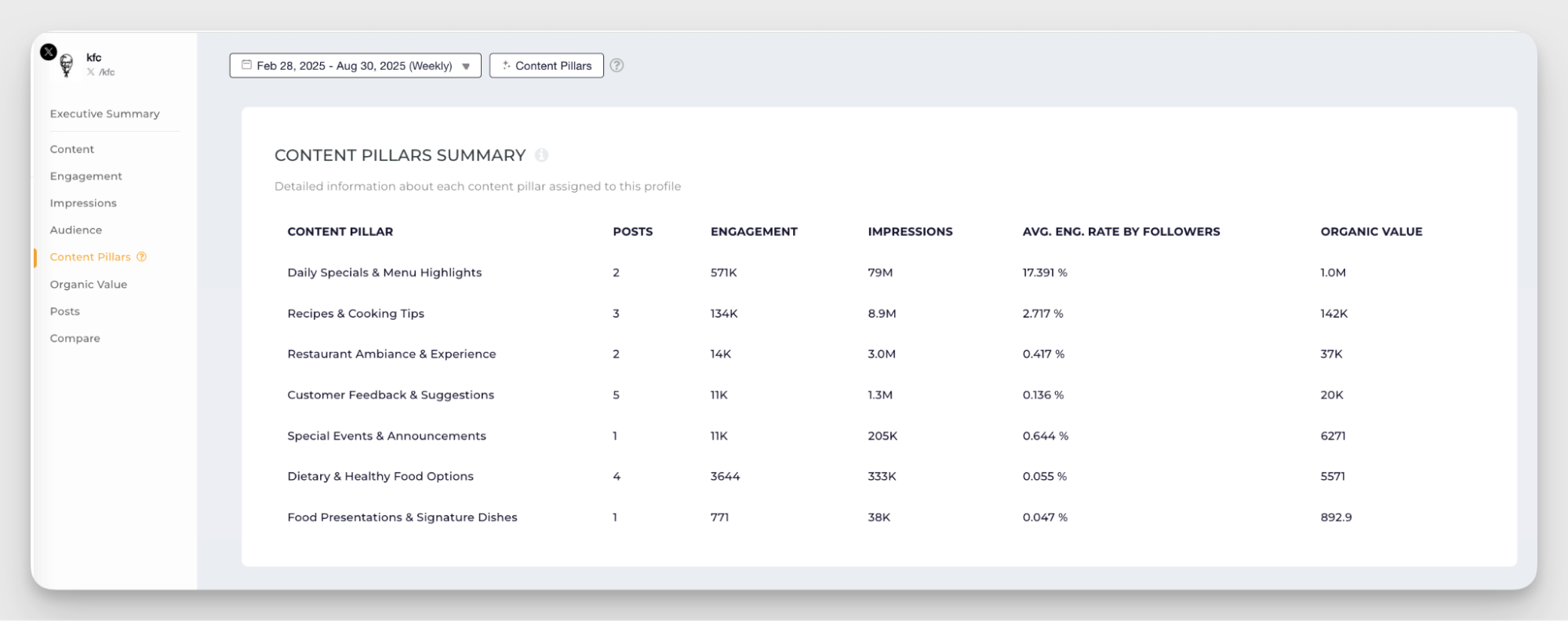
As you can see, KFC focuses heavily on "Customer Feedback and Suggestions" with 5 posts, but “Daily Specials and Menu Highlights” gets much more engagement.
Next, I'd examine this at an industry level to spot common patterns across competitors — like Wendy’s, for example.

As seen, the top 3 content pillars are rather the same for both brands. The main insights from here? While KFC leans into customer feedback content, Wendy’s is going more into dietary and healthy food options. However, based on the engagement data, KFC’s message is landing better. Also, KFC not leaning more into its most engaging pillar shows an opportunity worth exploring.
Remember to look at the content pillars both at an industry level and individually for each competitor to see how they differentiate themselves.
Then I'd look at best-performing content formats. This analysis tells you which content types work for your shared audience.
For KFC, photos completely dominate both total engagement and average engagement.
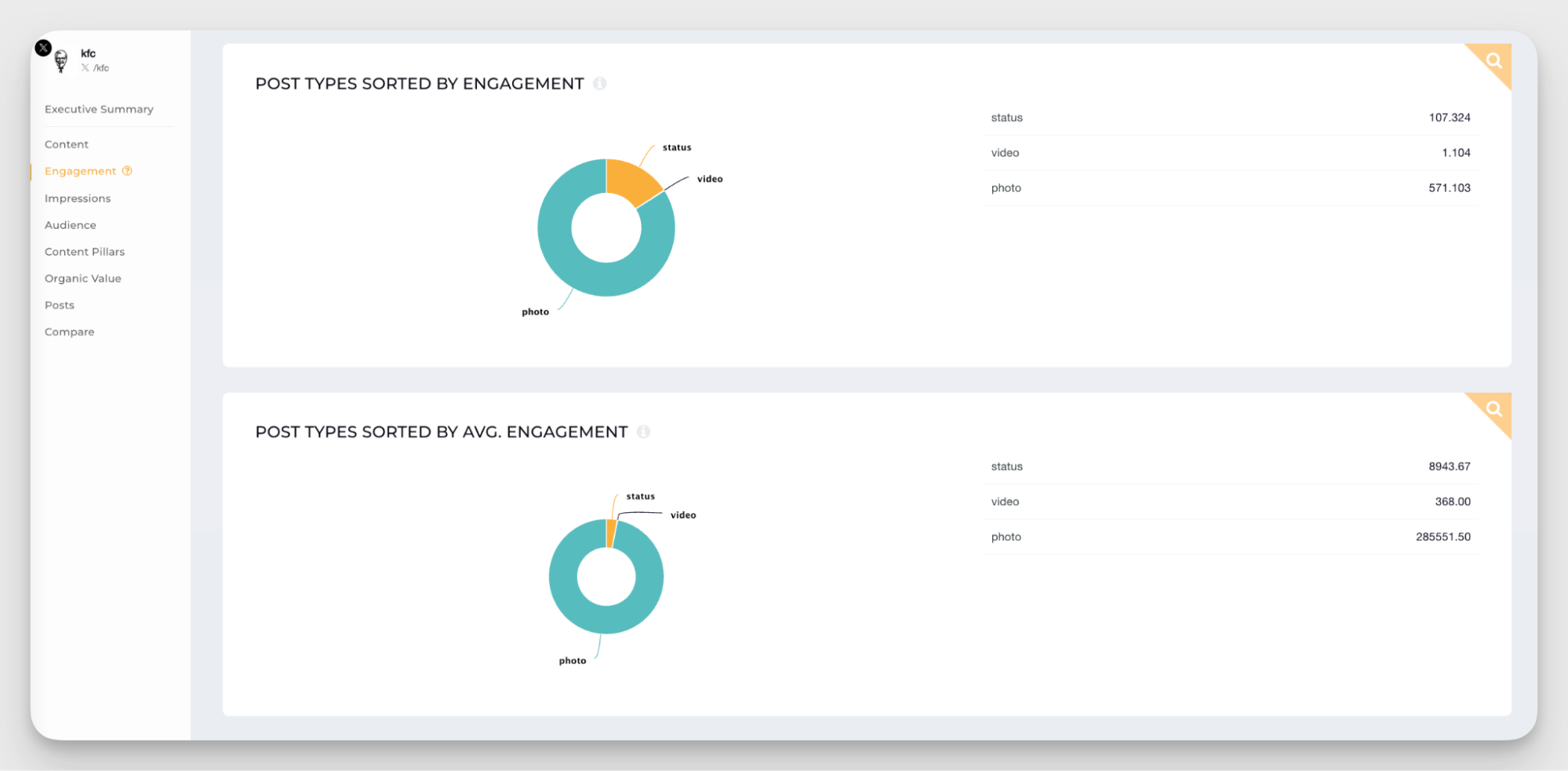
Surprisingly enough, video content is the least engaging one. This might be that KFC is not making good enough videos, or it might be a trend that video content on Twitter is not working well in this industry.
I recommend cross-checking it with another competitor: if multiple accounts show low engagement on video, it might be a sign that it’s not a content type worth investing in on Twitter.
Finally, I'd identify the best and worst posts to understand what drives engagement and what completely bombs.
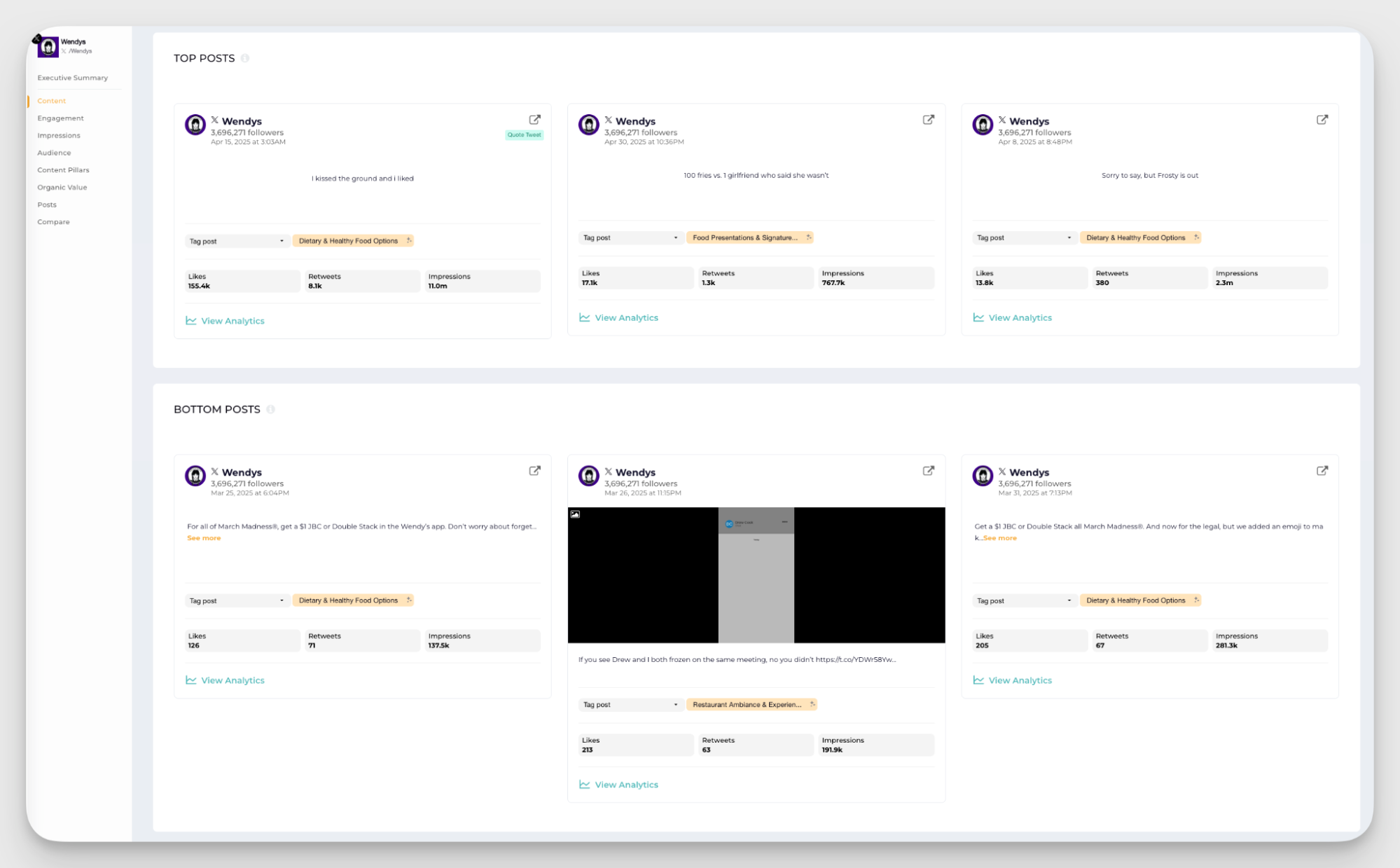
Looking at Wendy's top performers, I can see that their short and snappy status updates perform the best. At the same time, their more promotional posts are among the worst performers. That tells me Wendy’s followers are not into classic promotion and prefer conversational, funny updates with a touch of meme.
This insight can be very useful to get a big picture of what topics, formats, and messaging styles resonate with your target audience and what falls flat.
Here's what I advise you to keep in mind when doing your analysis:
- Monitor historical growth patterns. Track how competitors grew over 6-12 months to spot successful tactics and timing strategies
- Identify seasonal growth variations. Notice if they spike during certain months or events. This can help you plan your own content calendar around industry trends
Turn your findings into a strategic SWOT analysis
Now it's time to make sense of the data gathered. A SWOT analysis will help translate raw metrics into actionable insights for your Twitter strategy.
- Strengths
Look at what your competitors are absolutely nailing. It can be a very successful video series or a consistent use of educational threads. Data-driven marketing means acknowledging when others are doing something better than you and learning from it.
Identify 3-5 key strengths across your competitor set. Do they have a content format that always performs well? Is there a certain tone of voice that seems to be working very well? Are they actively engaging in conversation with the followers?
This becomes your playbook for social media best practices that you can adapt for your own brand.
- Weaknesses
Every competitor has gaps, and those gaps are your goldmine. Maybe they post sporadically, ignore customer replies, or stick to boring corporate speak while their audience craves personality.
Your social media analysis should reveal these weak spots clearly. Look for low engagement rates on certain content types, slow response times, or topics they completely ignore. These weaknesses become your competitive advantages when you do them better.
- Opportunities
Based on competitor data, spot the untapped potential in your market.
Perhaps everyone's focusing on educational content, but nobody's creating entertaining posts. Or maybe there's a content format that works well but is not widely used yet. Or no one in your industry ever goes around X commenting on others’ posts.
These opportunities come directly from competitors’ data collection and landscape analysis. Both their weaknesses and strengths can be your chance to put a foot in the door.
- Threats
Be honest about which competitors could hurt your growth. They can gain followers faster, have better engagement, or move into your content territory.
Understanding these threats helps you stay defensive while planning your offensive moves. That doesn’t mean you have to brawl a fight in their comment section, but rather make sure you’re not getting left behind.
Use the potential threats as additional benchmarks — you have to be doing better than these brands to stay afloat.
Create an action plan based on your Twitter competitive analysis
All this competitor monitoring means nothing if you don't act on it. Time to turn your insights into a concrete roadmap that moves your X content strategy forward.
Changing a lot way too fast can be overwhelming for you and your followers. Divide your action plan into the following three time frames:
- Quick wins (1 month)
I recommend that you start with changes you can implement immediately and that are relatively simple.
Maybe your competitor analysis revealed a more optimal posting time that you can try out. Or you noticed competitors using a specific hashtag that's driving conversations in your industry.
Look for low-hanging fruit like optimizing your bio based on successful competitor examples, adjusting your posting frequency, or trying a content format that's working well for others.
These social media optimizations are easy to test and quick to implement, giving you immediate momentum while you work on bigger changes.
- Medium-term improvements (1-3 months)
This is where your competitive insights and general social media benchmarks help you set realistic goals and forecast growth.
What patterns did you notice in your competitors? Say, they use at least 2 videos a week, two educational threads, and one static meme. This brings them an average of 500 new followers every month.
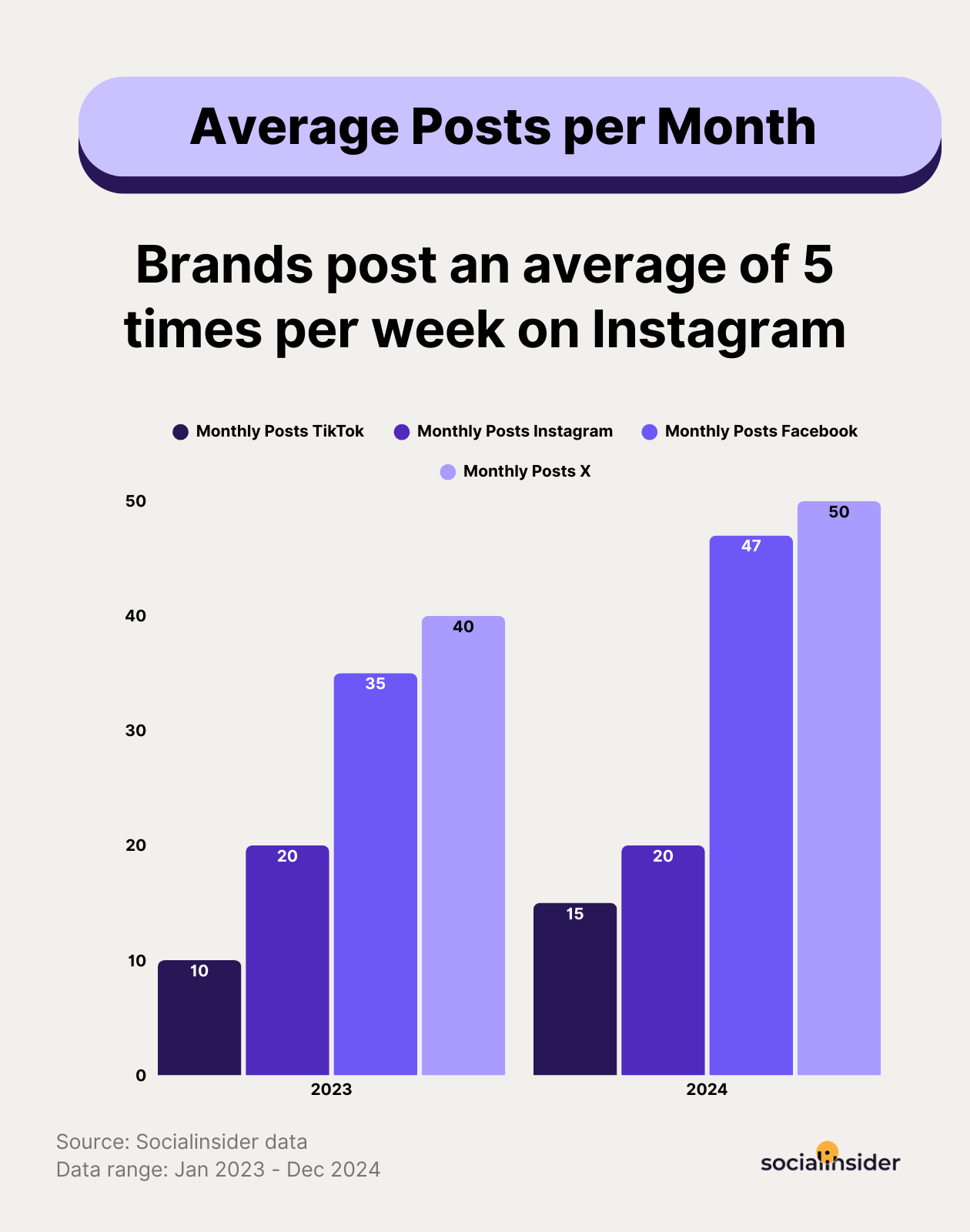
Use this data to set up realistic social media KPIs for your account and adjust the strategy to reach them. Plan content calendar adjustments, experiment with new formats, or develop a community management strategy based on what you've learned.
- Long-term strategic shifts (3-6 months)
This category is saved for bigger picture changes that require more planning and resources.
These strategic shifts might include launching new content series, repositioning your brand voice, or investing in video production. For example, your analysis revealed that competitors are building strong personal brands for their executives. That would take more time and resources to achieve, should you decide it’s necessary for your brand.
Your competitor analysis gives you the data to justify these investments and predict their potential impact.
Final thoughts
Regular Twitter competitor analysis is your main tool to stay ahead of the curve. Competitor analysis helps you set more realistic goals and KPIs, evaluate your performance in the market context, and find new ideas for content.
The goal isn't to copy everything your competitors do. Twitter competitive research is about understanding the landscape so you can find your unique angle. Use their successes and failures as lessons and their failures as warnings.
Social media moves fast, and what worked for competitors last quarter might already be outdated. Make competitor research a regular habit, not a one-time deep dive. Gather the data, spot the patterns, make your plan, and start testing!
Kseniia Volodina
Content marketer with a background in journalism; digital nomad, and tech geek. In love with blogs, storytelling, strategies, and old-school Instagram. If it can be written, I probably wrote it.
Analyze your competitors in seconds
Track & analyze your competitors and get top social media metrics and more!
You might also like
Improve your social media strategy with Socialinsider!
Use in-depth data to measure your social accounts’ performance, analyze competitors, and gain insights to improve your strategy.



